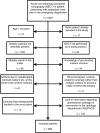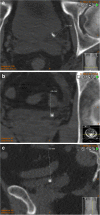Size matters: The width and location of a ureteral stone accurately predict the chance of spontaneous passage
- PMID: 28593428
- PMCID: PMC5635101
- DOI: 10.1007/s00330-017-4852-6
Size matters: The width and location of a ureteral stone accurately predict the chance of spontaneous passage
Abstract
Objectives: To determine how to most accurately predict the chance of spontaneous passage of a ureteral stone using information in the diagnostic non-enhanced computed tomography (NECT) and to create predictive models with smaller stone size intervals than previously possible.
Methods: Retrospectively 392 consecutive patients with ureteric stone on NECT were included. Three radiologists independently measured the stone size. Stone location, side, hydronephrosis, CRP, medical expulsion therapy (MET) and all follow-up radiology until stone expulsion or 26 weeks were recorded. Logistic regressions were performed with spontaneous stone passage in 4 weeks and 20 weeks as the dependent variable.
Results: The spontaneous passage rate in 20 weeks was 312 out of 392 stones, 98% in 0-2 mm, 98% in 3 mm, 81% in 4 mm, 65% in 5 mm, 33% in 6 mm and 9% in ≥6.5 mm wide stones. The stone size and location predicted spontaneous ureteric stone passage. The side and the grade of hydronephrosis only predicted stone passage in specific subgroups.
Conclusion: Spontaneous passage of a ureteral stone can be predicted with high accuracy with the information available in the NECT. We present a prediction method based on stone size and location.
Key points: • Non-enhanced computed tomography can predict the outcome of ureteral stones. • Stone size and location are the most important predictors of spontaneous passage. • Prediction models based on stone width or length and stone location are introduced. • The observed passage rates for stone size in mm-intervals are reported. • Clinicians can make better decisions about treatment.
Keywords: Kidney stone; Renal colic; Spiral computed tomography; Ureter; Ureteral calculi.
Conflict of interest statement
The authors of this manuscript declare no relationships with any companies whose products or services may be related to the subject matter of the article.
Figures






References
-
- Sandegård E. Prognosis of stone in the ureter. Acta Chir Scand Suppl. 1956;219:1–67. - PubMed
MeSH terms
LinkOut - more resources
Full Text Sources
Other Literature Sources
Medical
Research Materials
Miscellaneous

